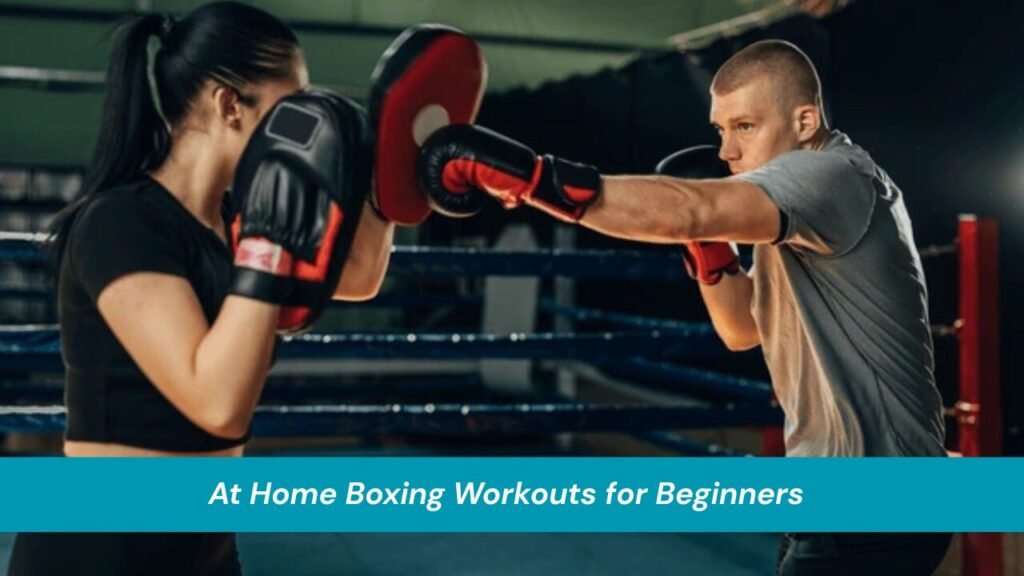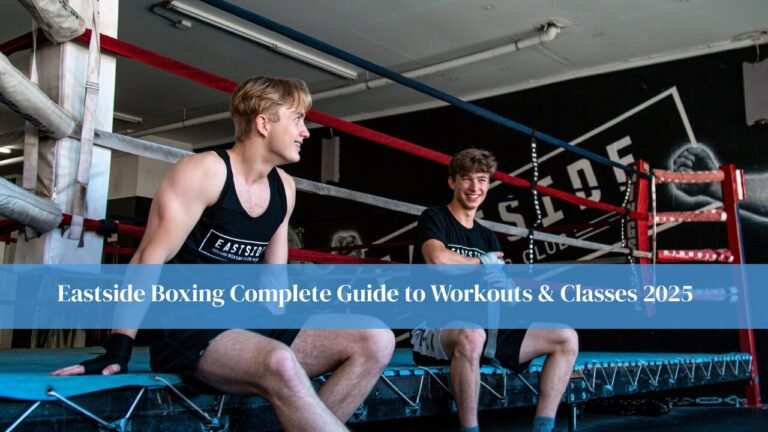Boxing has long been admired as one of the most dynamic sports in the world. Beyond the ring and the bright lights of professional bouts, it has quietly established itself as one of the most effective full-body workouts available to anyone, anywhere. In recent years, more and more people have discovered the benefits of at home boxing workouts for beginners, recognizing that you don’t need a gym membership or a sparring partner to reap the rewards of this challenging yet highly rewarding training method.
What makes boxing unique compared to other workouts is the way it blends cardiovascular training, strength development, agility, and mental discipline into a single session. Beginners often assume that boxing is purely about throwing punches, but it is much more comprehensive than that. It requires focus, footwork, timing, and coordination, making it not just a physical exercise but also a mental one. For those who want to build fitness at home without relying on heavy gym equipment, boxing is an excellent choice.
This guide will walk you through the foundations of at-home boxing, including the benefits, essential gear, structured workouts, and expert tips that will help you train effectively. By the end, you will not only know how to get started with boxing at home but also understand how to progress at your own pace while enjoying every step of the journey.
Why Boxing at Home Is Ideal for Beginners
Many beginners hesitate to start boxing because they imagine that it requires expensive equipment, a dedicated gym, or professional training. The reality is much simpler: boxing can be done almost anywhere. All you need is a small space, comfortable clothing, and the willingness to learn. Training at home has several advantages, especially for beginners who are still building confidence and exploring whether the sport is right for them.
One of the primary reasons boxing at home is appealing is accessibility. You do not need to commit to a costly membership or commute to a specialized gym. With just a few feet of space in your living room or garage, you can begin shadowboxing, practicing basic movements, and working on combinations. This convenience removes the barriers that often prevent people from sticking to a new fitness routine.
Another important factor is efficiency. A thirty-minute boxing workout has been shown to burn anywhere from 300 to 500 calories, depending on the intensity. This means that even short sessions performed consistently at home can lead to significant improvements in cardiovascular endurance, muscular strength, and fat loss. According to the American Council on Exercise, high-intensity boxing drills engage multiple muscle groups simultaneously, allowing you to achieve more in less time compared to traditional isolated exercises.
Training at home also provides a unique opportunity for stress relief. The act of punching, whether into the air through shadowboxing or against a bag, is a natural outlet for frustration and tension. This makes it not only a workout for the body but also a therapeutic practice for the mind. Beginners often find that boxing quickly becomes a favorite way to release daily stress while still making progress toward their fitness goals.
Finally, boxing is highly scalable. Unlike some sports that require a steep learning curve, boxing allows you to start with the basics and gradually build complexity as you improve. A new boxer can begin with simple jab-cross combinations and, over time, expand into more advanced footwork, defensive moves, and longer sequences. This progression makes boxing a sustainable fitness option that can grow with you.
Essential Gear for At-Home Boxing
While it is possible to begin boxing at home with nothing but your bodyweight, having a few key pieces of equipment can enhance your experience and make training more effective. The most fundamental items are boxing gloves and hand wraps, which provide support and protection for your hands and wrists during bag work. Beginners who do not yet own a punching bag can still use gloves to get accustomed to their feel, but wraps are particularly important if you plan to hit any striking surface.
A punching bag or free-standing bag is not mandatory, but it can be a valuable investment if you want to practice power and endurance. Bags provide resistance that shadowboxing cannot, helping you develop both strength and timing. For those without space or budget for a bag, shadowboxing in front of a mirror is an excellent alternative. The mirror gives you visual feedback, allowing you to spot flaws in technique and improve form.
Cardio equipment such as a skipping rope can also be extremely helpful. Jump rope drills are a staple in boxing gyms worldwide because they build foot speed, coordination, and cardiovascular endurance. Even five to ten minutes of skipping can dramatically improve agility and stamina.
Finally, a simple timer or boxing app is an underrated but powerful tool. Since boxing is typically structured into timed rounds with rest intervals, having a way to track your rounds keeps workouts organized and ensures you are training in a way that mimics real boxing conditions. Many free apps are available that provide round timers and even suggest beginner combinations.
Beginner-Friendly At-Home Boxing Workouts
The beauty of boxing lies in its variety. Even at home, you can create workouts that are challenging, enjoyable, and adaptable to your fitness level. Below are three beginner-friendly routines designed to help you ease into boxing without feeling overwhelmed.
Shadowboxing Circuit
Shadowboxing is often overlooked by beginners who assume that punching the air is less effective than hitting a bag. In reality, shadowboxing is one of the most fundamental training methods in boxing. It allows you to practice technique, footwork, and combinations without worrying about power. A simple beginner routine might involve three-minute rounds with one-minute rests between them, just like professional fighters train.
For the first round, focus solely on the jab and cross, moving forward and backward while maintaining good stance and guard. In the second round, add the left hook to form a basic three-punch combination. The third round can emphasize defense, where you practice slipping punches, ducking, or pivoting. By the fourth round, you can mix these elements into a freestyle round, creating combinations while moving around your space.
This routine not only improves technique but also builds endurance and coordination. It is especially useful for beginners who are still becoming comfortable with the basic punches.
Conditioning Drill
A well-rounded boxing workout should combine skill training with conditioning. One effective beginner-friendly drill alternates between cardiovascular exercises and punching combinations. For example, you might begin with one minute of skipping rope or jumping jacks to elevate your heart rate. Immediately after, perform thirty seconds of rapid jab-cross combinations at full speed.
After this burst of boxing, you can switch to a bodyweight exercise such as push-ups or squats for a minute, followed by another punching interval, perhaps hooks and uppercuts this time. Repeating this sequence for four to five rounds creates a workout that challenges both your cardiovascular system and muscular endurance. Beginners will find that this style of training not only makes the session more engaging but also helps build stamina faster than traditional steady-state cardio.
Heavy Bag Routine
For those who invest in a punching bag, the workout possibilities expand considerably. A beginner heavy bag workout should still be structured in timed rounds. Start with two minutes of shadowboxing as a warm-up to get your body moving.
In the first round on the bag, focus on the basic jab-cross combination at a moderate pace, paying attention to accuracy and form. In the second round, emphasize hooks and uppercuts, which allow you to practice shorter-range power punches. The third round can be more freestyle, where you string together different combinations while moving around the bag.
To finish strong, try a conditioning round where you throw punches continuously for twenty seconds at maximum intensity, followed by ten seconds of rest. Repeat this cycle four times within a single round. This kind of high-intensity interval develops explosive power and endurance simultaneously.
Key Techniques Every Beginner Should Learn
Before diving too deeply into complex workouts, beginners must prioritize learning proper technique. The boxing stance is the foundation of everything. Stand with your feet shoulder-width apart, knees slightly bent, and your lead foot pointing forward while your rear foot turns outward at a comfortable angle. This balanced stance provides both stability and mobility.
Your guard position is equally critical. Keep your hands raised near your face, elbows tucked close to your body, and chin slightly down. This position protects you from incoming strikes while allowing quick offensive movements.
The four basic punches every beginner must master are the jab, cross, hook, and uppercut. The jab is thrown with the lead hand and serves as both a defensive and offensive tool. The cross is a powerful straight punch from the rear hand. The hook, typically thrown from the lead hand, arcs sideways toward the target, while the uppercut rises from below, making it effective at close range.
Defensive skills are just as important as offensive ones. Beginners should practice slipping (moving the head slightly to avoid a punch), ducking under hooks, and blocking with the gloves. These techniques prevent injuries and make workouts more realistic.
By consistently practicing these fundamentals, you create a strong technical base. Once the basics feel natural, you can begin experimenting with more advanced combinations and strategies.
Tips for Staying Consistent with At-Home Boxing
The most challenging part of any new workout routine is consistency. Boxing can be demanding, and beginners often feel discouraged if progress seems slow. Establishing a routine is key. Aim to schedule three to four boxing sessions per week, treating them as non-negotiable appointments.
Tracking progress also keeps motivation high. Keep a notebook or use a training app to log your workouts, recording how many rounds you completed and which combinations you practiced. Over time, seeing measurable progress will reinforce your commitment.
Variety is another important factor. Mixing shadowboxing, conditioning drills, and bag work prevents boredom and keeps your body adapting to new challenges. Even small changes, such as introducing new combinations or adjusting round lengths, can make workouts more engaging.
Finally, safety must remain a priority. Beginners sometimes push too hard too soon, risking injury. Always begin with a warm-up, maintain proper form, and listen to your body. Boxing is meant to build strength and endurance, not to cause unnecessary strain.
FAQs
1. How long should a beginner’s boxing workout last?
Most beginners do well with sessions lasting between twenty and thirty minutes, three times per week. As your stamina improves, you can gradually extend sessions to forty-five minutes or more.
2. Do I need a punching bag to start boxing at home?
A punching bag is not required for beginners. Shadowboxing and bodyweight drills can provide excellent training benefits without any equipment. That said, a bag can be a valuable tool once you are comfortable with the basics.
3. Can boxing help with weight loss?
Yes, boxing is one of the most effective workouts for burning calories. A person weighing 155 pounds can burn up to 400 calories in just thirty minutes of moderate-intensity boxing, according to research from Harvard Health.
4. Is boxing safe for beginners at home?
Boxing is safe as long as proper form is maintained. Beginners should avoid overextending punches and always warm up before training. With attention to technique and gradual progression, the risk of injury is minimal.
5. Do I need a trainer to start boxing?
While having a coach can accelerate progress, it is not essential for beginners. With the wealth of online tutorials, structured apps, and guides like this one, you can safely and effectively begin boxing at home.
Conclusion
Boxing offers one of the most effective and enjoyable ways to improve fitness without leaving your home. For beginners, it provides a combination of strength, endurance, agility, and mental discipline that few other workouts can match. By starting with the basics of stance, guard, and simple combinations, and by following structured routines such as shadowboxing circuits, conditioning drills, and heavy bag sessions, you can build a solid foundation and continue progressing over time.
The key is to remain consistent, track your progress, and approach training with patience. Whether your goal is weight loss, strength, or simply an engaging new fitness habit, at-home boxing workouts give you all the tools you need to succeed. With nothing more than your determination and a small space to move, you can begin your boxing journey today and discover why this sport has captivated athletes and fitness enthusiasts for generations. Visit Boxing Essential to explore more.




